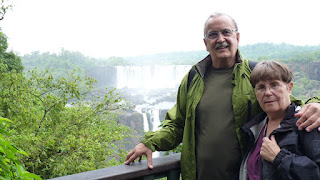We are back in Salta, by bus from Tilcara on Oct. 31. Staying in hotel near railroad station (also food and party area). One day relaxing then the train ride and on Saturday Nov 3 on to Tucuman for 3 nights by bus. We already booked our trip to Iguazu, it will be Tucuman - Iguazu 21 Hours by sleeper coach, the times are good, leaving 11:330AM arriving 9:30AM in Iguazu.
The most amazing
train in the world, the one that takes you to the clouds, reaches a height of
4,200 meters in its 217 km trip.
It is one of the highest railways in the world, taking its
way across the high picks of the Cordillera de los Andes, surrounded by
striking sceneries. The train departs from the city of Salta, passes through
the Valle de Lerma, enters the Quebrada del Toro and finally reaches La Puna.
It takes its name Tren a las Nubes, from the clouds
that are often seen under bridges and around slopes.
The number of spirals, viaducts, tunnels and other twists
and turns that the train passes through arises from a decision made by the
designer of this project, the US engineer Richard Maury. He took into account
the principle of adhesion of train wheels to the railways and the laws of
physics, ruling out the funicular system commonly used, so that the train may
safely reach the expected heights. The train has no cogwheels, not even for the
steepest slopes, since the railways are peculiarly arranged, running through a
system of zigzags and spirals.
The train leaves from the General Belgrano station in the city of Salta, 1187
meters above the sea level, and ends its journey at the viaduct.
ROUTE
It leaves from the train station at the city of Salta and ends its route at
La Polvorilla Viaduct.
The railways reach a height of 4,200 meters above sea level, turning this train
into one of the highest in the world.
The train offers meals onboard, translator services, and medical assistant for
any passenger that may be affected by the lack of oxygen caused by the height. The
trip lasts approximately sixteen hours, from seven am until midnight or later.
The train runs 217 km. and passes through 29 bridges, 21 tunnels, 13 viaducts,
2 spirals, and 2 zigzags.
There are two stops throughout the trip: one at San Antonio de los Cobres
station, and the other one at La Polvorilla viaduct.
It leaves from the city of Salta, the lowest point, and from
there it begins the upward route until it reaches the final point at La
Polvorilla Viaduct, the highest in the trip. As you reach the different
stations, local villagers at picturesque stands sell craftwork, clothes, and
regional products as interesting souvenirs of the trip.
The train services include dining car, medical practice, audio, video, and
bilingual guides.
TECHNICAL
SPECIFICATIONS
Capacity: 468 passengers. Speed: 35
km/h.
On board services:
Tourism information guide. One assistant per car. Security personnel. Medical assistance. Nurses.
In German:
Zugreise in die Wolken
Touristisches Aushängeschild Saltas ist der "Tren a las Nubes", der "Zug in die Wolken". Er windet sich von der Hauptstadt aus an Schluchten vorbei durch Kakteenlandschaften, an deren Rändern Gletscherriesen wie der Nevado de Acay (5716 Meter) oder der Nevado de Chañí (5896 Meter) thronen. Das Ziel der 217 Kilometer langen Zugreise ist das Viadukt La Polvorilla auf 4220 Metern Seehöhe.
Auf dem Weg passiert der Zug, der wegen Konzessionsproblemen von 2005 bis 2008 nicht fahren konnte, 29 Brücken, 21 Tunnel und Behelfskonstruktionen wie "Zickzack-Weichen", ohne die manche Stelle nicht zu meistern wäre. Ganz billig ist der Spaß nicht: Je nach Saison sind 120 bis 140 US-Dollar (95 bis 110 Euro) für die rund 16-stündige Tour zu berappen. Campingeinrichtungen gibt es in der Landschaft nicht, und von "wildem Zelten" wird dringend abgeraten.
190 Kilometer südlich von Salta liegt als weiteres Ausflugsziel die für die Torrontés-Weißweine berühmte
Kleinstadt Cafayate, wo zwei Campingplätze Übernachtungsmöglichkeiten bieten. Von hier sind es nur rund 40 Kilometer bis zu den berühmten, schon in der Provinz Tucuman gelegenen Ruinen der Befestigungsanlagen der Quilmes-Indianer.













